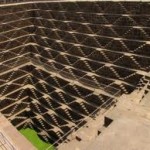Rajasthan is indeed the most colourful state in India. It has a unique architecture and is renowned for it all over the world. The architecture of Rajasthan is mainly based on the Rajput school of architecture which was a blend of the Hindu and Mughal structural design. The stupendous forts, the intricately carved temples, and the grand Havelis of the state are integral parts of the architectural heritage of the state. The Rajputs were prolific builders. Some of the most imposing and magnificent forts and palaces in the world dot the arid Aravali landscape and tell the tales of their glorious legacy.
Let us try to understand some of the important features of The Architecture of Rajasthan:
 Haveli
Haveli
Between 1830 and 1930, the affluent Marwaris constructed huge mansions in the Shekhawati and Marwar region. These buildings were called Havelis. They were heavily influenced by the Mughal architecture in their construction. There were two courtyards in a typical Shekhawati haveli. The outer courtyard was mainly inhabited by men and the inner one was the domain of women. The Havelis also sported beautiful and appealing frescoes and were closed from all sides with one large main gate. This provided security and comfort in seclusion from the outside world.
Chhatri
Ori ginating in Rajasthan, chhatris are elevated, dome-shaped pavilions and are visible elements of the Rajasthani architecture, where they are the symbols of pride and honour. In the Shekhawati region of Rajasthan, chhatris are built on the cremation sites of wealthy or distinguished people. Chhatris in Shekhawati are usually of a simple structure of one dome raised by four pillars in a building containing many domes and a basement with several rooms. Many prominent chhatris exist in cities like Jaipur, Jodhpur, Udaipur, Haldighati, Bikaner, etc.
ginating in Rajasthan, chhatris are elevated, dome-shaped pavilions and are visible elements of the Rajasthani architecture, where they are the symbols of pride and honour. In the Shekhawati region of Rajasthan, chhatris are built on the cremation sites of wealthy or distinguished people. Chhatris in Shekhawati are usually of a simple structure of one dome raised by four pillars in a building containing many domes and a basement with several rooms. Many prominent chhatris exist in cities like Jaipur, Jodhpur, Udaipur, Haldighati, Bikaner, etc.
Jharokha
I t’s a type of overhanging enclosed balcony which is commonly found in palaces, havelis and temples in Rajasthan. This balcony is normally a stone window. Jharokhas jut forward from the wall plane and can be used for either adding to the architectural beauty of the building itself or for a specific purpose. In the ancient times, the women in purdah could see the events outside without being spotted themselves. The projected balcony, which is an essential element of the Rajasthani Architecture, served as a decoration piece and as a viewing platform. Many jharokhas also have chhajjas attached to them.
t’s a type of overhanging enclosed balcony which is commonly found in palaces, havelis and temples in Rajasthan. This balcony is normally a stone window. Jharokhas jut forward from the wall plane and can be used for either adding to the architectural beauty of the building itself or for a specific purpose. In the ancient times, the women in purdah could see the events outside without being spotted themselves. The projected balcony, which is an essential element of the Rajasthani Architecture, served as a decoration piece and as a viewing platform. Many jharokhas also have chhajjas attached to them.
Step well
well
A stepwell (or a bawdi) is a well or pond in which the water can be reached by climbing down a set of steps. These bawdis are common in the Western India, especially in Rajasthan and Gujarat. Stepwells have been in existence for hundreds of years. In the ancient times, builders dug deep trenches into the earth for dependable, year-round groundwater. The walls of these trenches were lined with stoneblocks but without mortar. Stairs were created leading down to the water. The majority of surviving stepwells originally also served as leisure points, as well as provided water. The city of Bundi (near Kota) has as many as 60 stepwells.
Town Planning in Rajasthan
Though Rajasthan was primarily rural, there were a few towns as well. And they did have a wonderful town planning system. The towns were mostly the villages that had expanded by the virtue of their dimension and increased population. Security in towns was ensured by the means of strong walls and hills. They were divided into wards which were connected by narrow streets and lanes. The temples, wells, gardens and palaces were important parts of these towns. The main road of the town was lined with shops selling cloth, jewellery, fruits, food items, etc.


One Reply to “The Architecture of Rajasthan: Grand, Awe-Inspiring, and Unique”
Comments are closed.